This page contains affiliate links. Please read our disclosure for more info.
The Kyoto cherry blossom season is a big deal. Locals and tourists flock to the city in spring for the fleeting week or two when the cherry trees bloom.
Cherry blossoms (sakura in Japanese) are found everywhere in Kyoto—along canals and streets and in parks and temples. They are a truly magical sight.
Locals take sakura viewing (hanami) seriously and they hit the parks in big groups for picnics to admire the flowers, drink, and eat cherry blossom themed food (mmm, sakura and sake kit kats!).
It may be crowded, but it’s a joyous time, and we did manage to find some quieter spots.
In this post, I share our favourite places to see the Kyoto cherry blossoms. You could visit most of the spots in Gion and Higashiyama in one day.
It’s best to spend at least a few days in Kyoto, though, so that you can visit the popular sakura spots early in the morning to avoid the crowds.
After our time in Kyoto we spent three weeks travelling around Japan and managed to follow the blossoms. Below I’ve included my tips on other less crowded sakura spots beyond Kyoto.
This post also includes the Kyoto cherry blossom forecast for 2025.
Contents
- The Best Time to Visit Kyoto for Cherry Blossoms
- Where to Stay for Kyoto Sakura Season
- Popular Kyoto Cherry Blossom Spots
- Kyoto Sakura Spots to Avoid the Crowds
- Kyoto Cherry Blossom Map
- Other Kyoto Spring Activities
- Sakura Beyond Kyoto
- Is Kyoto Cherry Blossom Season Worth it?
- More Japan Posts
The Best Time to Visit Kyoto for Cherry Blossoms
It’s difficult to plan a trip to Kyoto to see the cherry blossoms as every year they bloom at different times.
Sakura usually happens in late March or early April—the first week of April is probably the safest bet if you need to plan in advance.
A few months beforehand you can follow the sakura forecasts to see the estimated bloom dates.
This will include the date for the first bloom (when the blossoms first start to appear) and the full bloom (when most flowers are blooming).
Full bloom happens about a week after first bloom and lasts for about a week.
Bad weather can reduce the blooming period, though. If possible, try to time your trip for the start of the full bloom.
The sakura forecasts refer to the somei yoshino, which is the most popular variety of cherry tree with pale pink five-petal blossoms.
There are other varieties of sakura that you may be able to see before or after the official cherry blossom season.
In 2024, Kyoto’s cherry blossoms had the first bloom on 29 March and full bloom on 5 April lasting until around 12 April.
Plan as much as you can, but don’t stress too much about predicting the perfect dates. Even if you miss the sakura, there are so many amazing things to do in Kyoto that you’ll still have a wonderful trip.
Our Experience of Kyoto Sakura Season
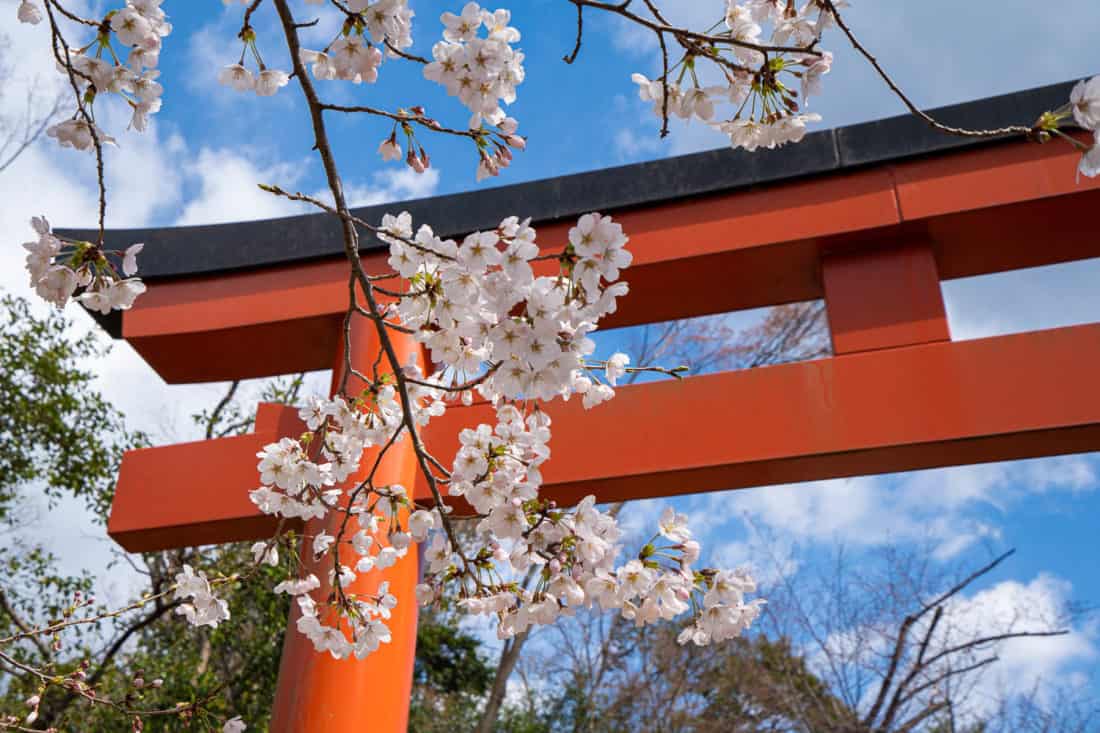
On our Kyoto sakura trip, the first bloom was officially 27 March, but the trees were only just beginning to flower then. We found the occasional tree in full bloom but not whole lines of them.
Full bloom took place nine days later on 5 April (cool weather slowed them down) and the best viewing continued until 13 April. This was slightly later than earlier forecasts had suggested.
Unfortunately, we had to leave Kyoto on 2 April, but we still saw beautiful sakura at the end of March and 1st of April.
Kyoto Cherry Blossom Forecast for 2025
The first cherry blossom forecast for Kyoto in 2025 was released on 23 January and has been updated regularly since then (it gets more accurate in March).
The current prediction for 2025 is fairly typical—the first bloom is expected on 26 March and the full bloom by 2 April. As usual, the first week of April should be a good time to visit.
You can see this Kyoto cherry blossom calendar for the latest updates during the season to see how the flowers are progressing at different locations across the city.
Elsewhere in Japan
If you are travelling around Japan, you’ll also want to check the cherry blossom forecasts for different areas.
Osaka usually blooms around the same time as Kyoto. In 2025, it has the same forecast.
In Tokyo, the trees can bloom a few days or even up to a week earlier. In 2025, this looks like 22 March as first bloom and 27 March for full bloom.
Sakura in Takayama and the Fuji Five Lakes area (including Kawaguchiko) arrive a few weeks later in mid-April.
Recommended Reading: Planning a Trip to Japan: Dos and Don’ts
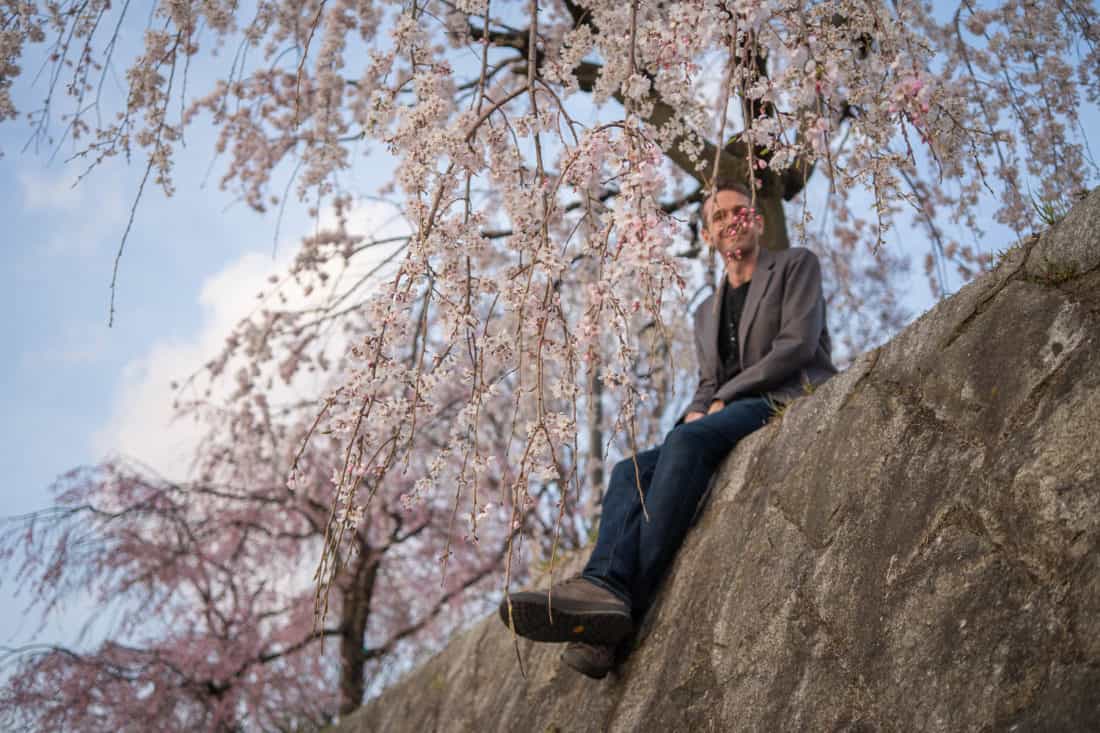
Where to Stay for Kyoto Sakura Season
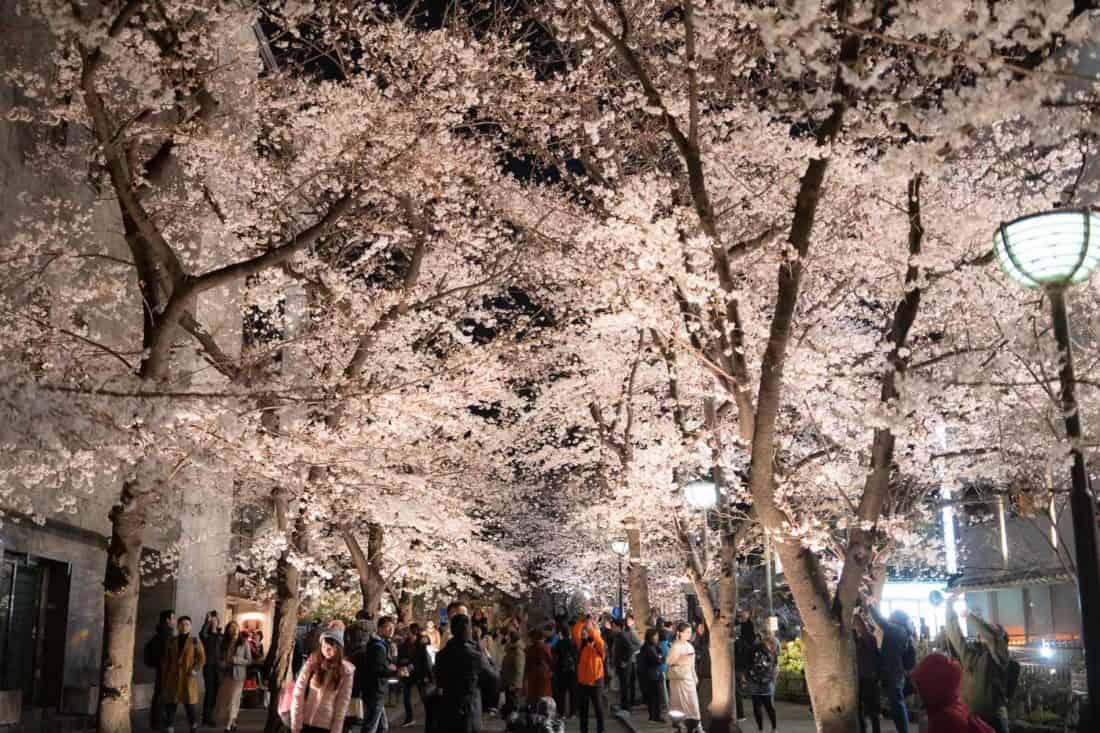
You definitely need to book accommodation far in advance for cherry blossom season in Kyoto as it’s the most popular time of year. Prices will be significantly higher.
I recommend staying as close to the cherry blossom spots as possible so that you can beat the crowds by arriving very early in the morning.
Gion and Higashiyama are the best areas to stay as you’ll be able to walk to most of the places on this list (except those in Arashiyama).
See my guide to the best places to stay in Kyoto for tips on neighbourhoods and recommendations of hotels we’ve personally stayed in.

Here are some hotels we love in Kyoto:
- Hotel The Celestine Kyoto Gion – Stylish rooms and onsen bath in a quiet area only a 5-minute walk from Yasaka Pagoda and Ninenzaka.
- Sora Niwa Terrace – Just across the river from Gion, this new downtown hotel is close to shopping and has fantastic views from its onsen and rooftop terrace (we loved having a drink with a footbath!). Rooms are small but well designed.
- Ryokan Yachiyo – For a splurge, choose a suite with private onsen at this traditional ryokan. Our room was huge and overlooked Keage Incline—a popular spring spot. It’s only a few minutes’ walk from Nanzenji and the Philosopher’s Path.
Search for more hotels in Kyoto here.
If you are looking for more affordable options, consider these:
- APA Hotel Kyoto Gion Excellent – A budget hotel in the heart of the action of Gion.
- Haruya Higashiyama – A budget hostel in a traditional house in a convenient location.
Popular Kyoto Cherry Blossom Spots
These popular Kyoto cherry blossom viewing spots get extremely crowded.
It’s best to visit them early in the morning (at sunrise ideally) then later in the day explore some of the less crowded spots that I’ve recommended below.
We visited all of these places on foot walking from south to north Higashiyama in the east of the city.
It’s about 5 km (3.1 miles) without detours from Yasaka Pagoda to the end of the Philosopher’s Path near Ginkaku-ji (covering 1 – 5 on the list).
It’s possible to visit all of these in one day, but spreading it over a few days would be better.
You’ll find a map of all these spots near the end of the post.
You can also see my detailed post on what to do in Kyoto for more tips on avoiding the crowds and other non-sakura activities.
1) Yasaka Padoda and Ninenzaka and Sannenzaka Streets
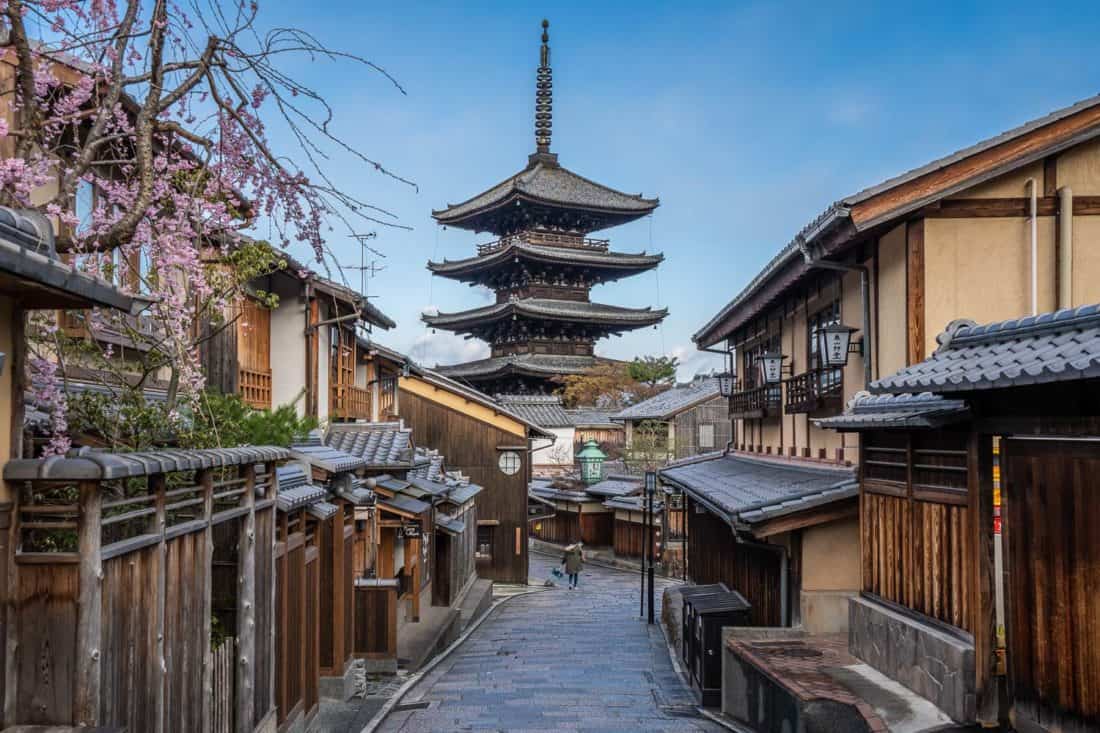
The preserved streets of wooden houses in south Higashiyama leading up to Kiyomizu-dera are some of the most picturesque in Kyoto.
Add in some weeping cherry trees and this is one of the most popular photo spots in the city.
It’s gorgeous, but expect crowds—even at 6 am I found it stressful trying to take a photo.
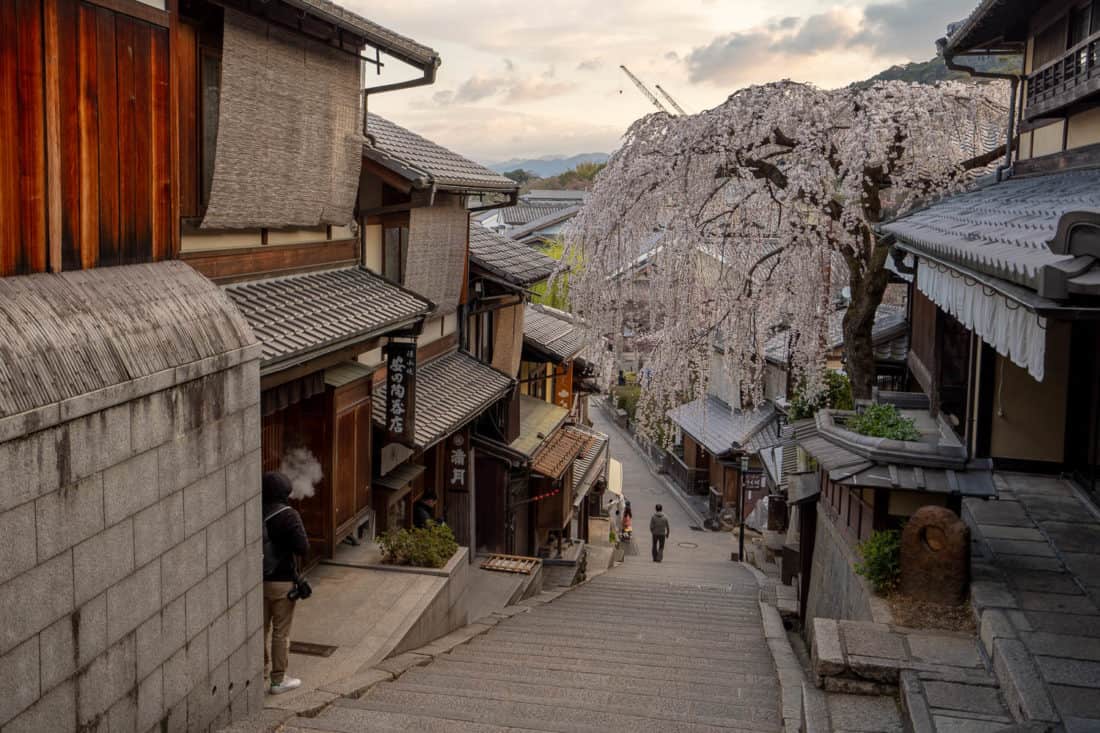
The classic view is of Yasaka Pagoda from the street that leads uphill above it, and then you can continue up to the narrow lanes Ninenzaka and Sannenzaka.
2) Kodai-ji Temple
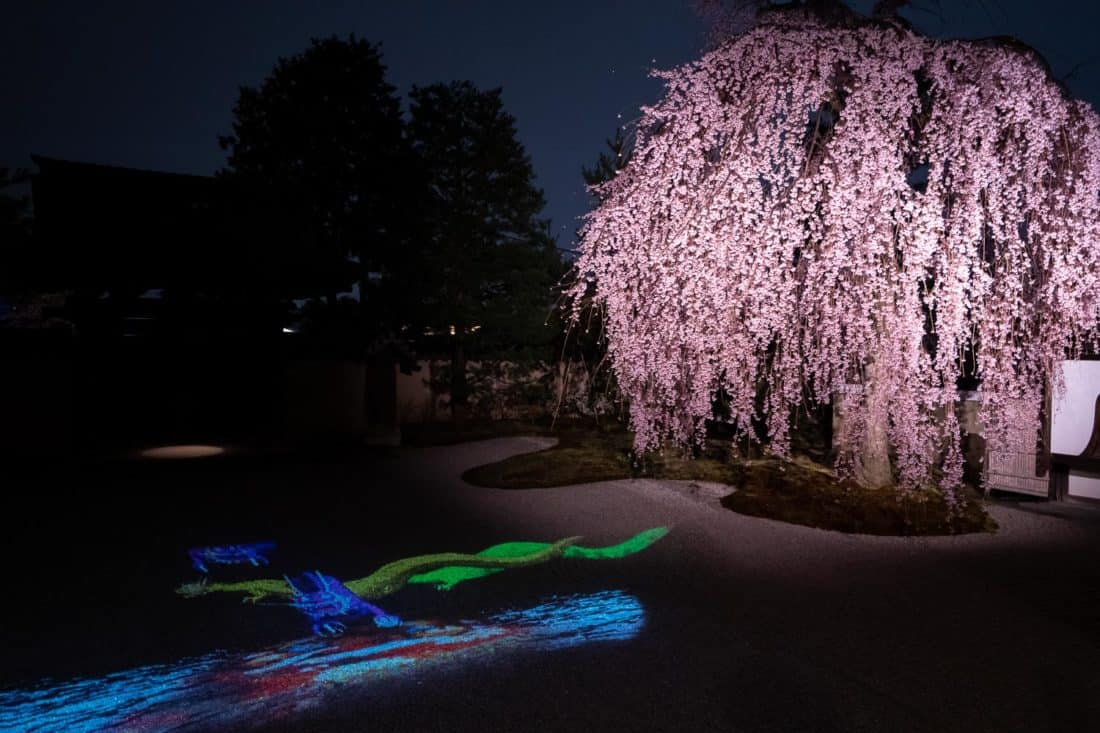
Outside sakura season, Kodai-ji is a quiet temple in one of the busiest areas. It features a beautiful raked gravel garden and a small bamboo grove.
Although it attracts more crowds in spring, it’s well worth visiting to see the weeping cherry tree blooming over the gravel garden.
You might also want to return at night when it’s open for illuminations—the tree lights up in different colours and animated characters zoom across the gravel.
The bamboo grove is also very atmospheric in the darkness.
The entrance fee is 600 yen.
3) Maruyama Park
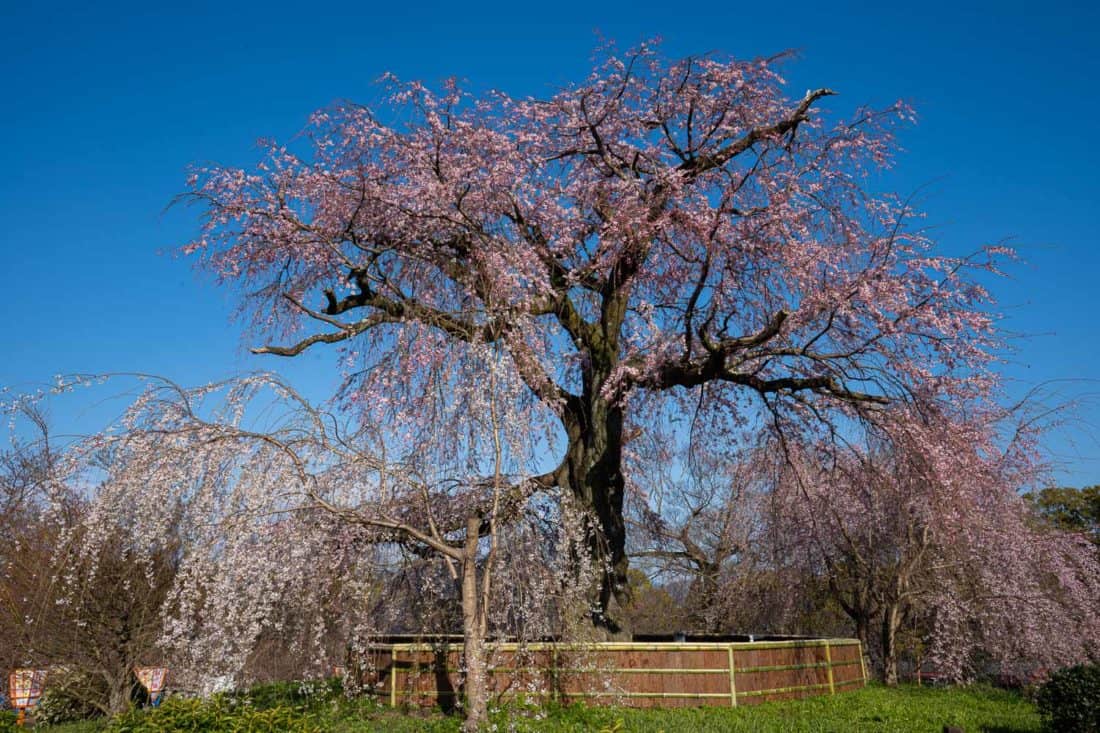
A little further north from Kodai-ji is Maruyama Park, the most popular spot for hanami parties in Kyoto.
Locals arrive early in the morning to save a picnic spot and then gather with friends to drink and eat all day and into the night.
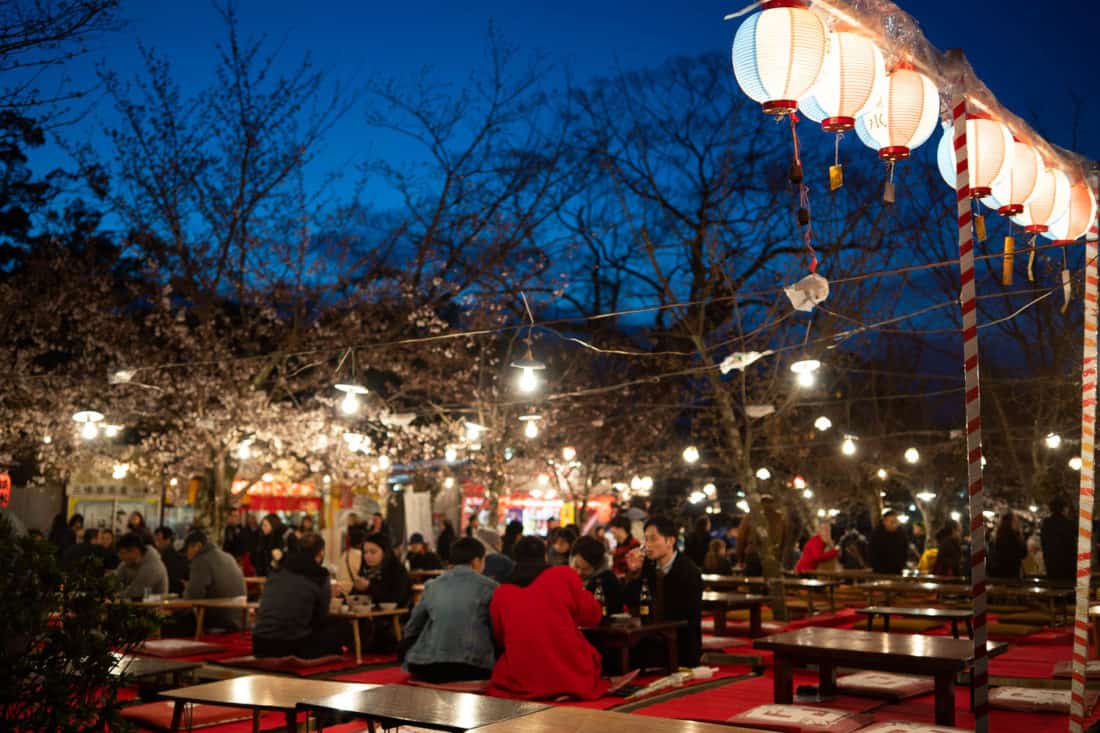
Honestly, I don’t think it’s the best place for a picnic as grass is limited and it’s so crowded, but it’s definitely worth a wander.
We visited before full bloom, but there are a couple of weeping cherry trees that were looking magnificent.
It’s also worth coming back in the evenings when it’s lit with lanterns and lively with food stalls and parties.
The food isn’t very veggie-friendly, but some of our favourite vegetarian-friendly restaurants in Kyoto are nearby (with options for meat-eaters too).
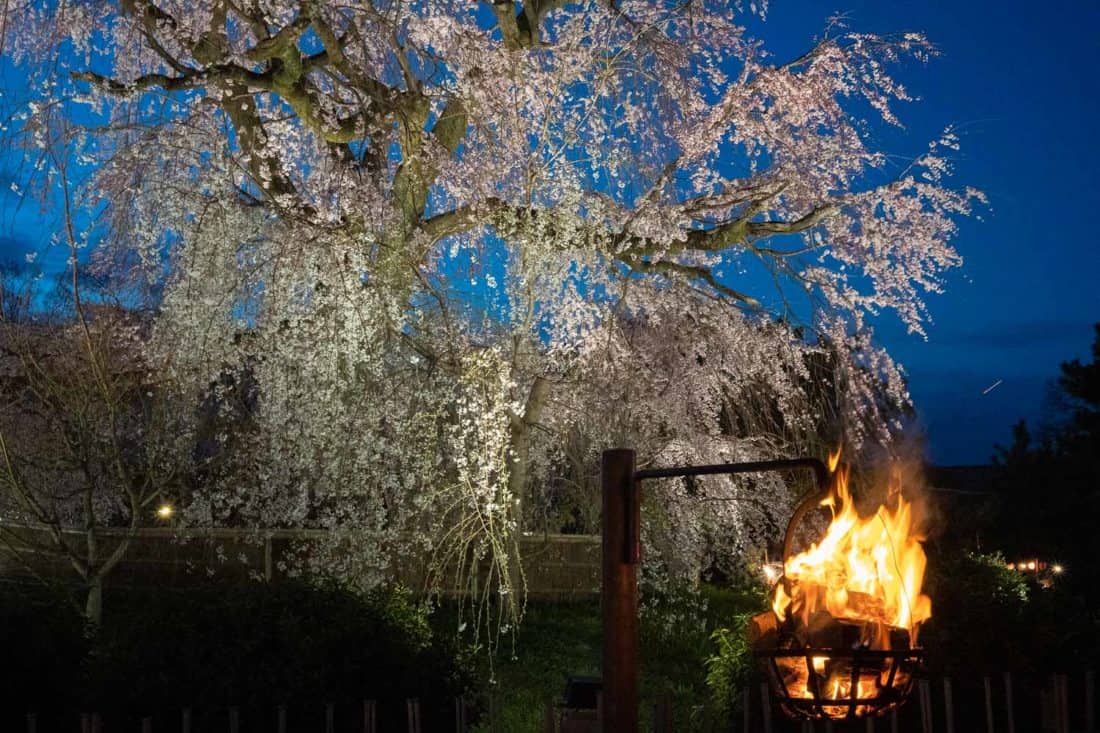
4) Keage Incline
It’s about a 20-minute walk from Maruyama Park to Keage Incline, but you might want to take a detour to the Lake Biwa Canal near Okazaki-dori.
The blooms weren’t very advanced in late March, but I could see it looking amazing a week later (you can also take boat trips down here).
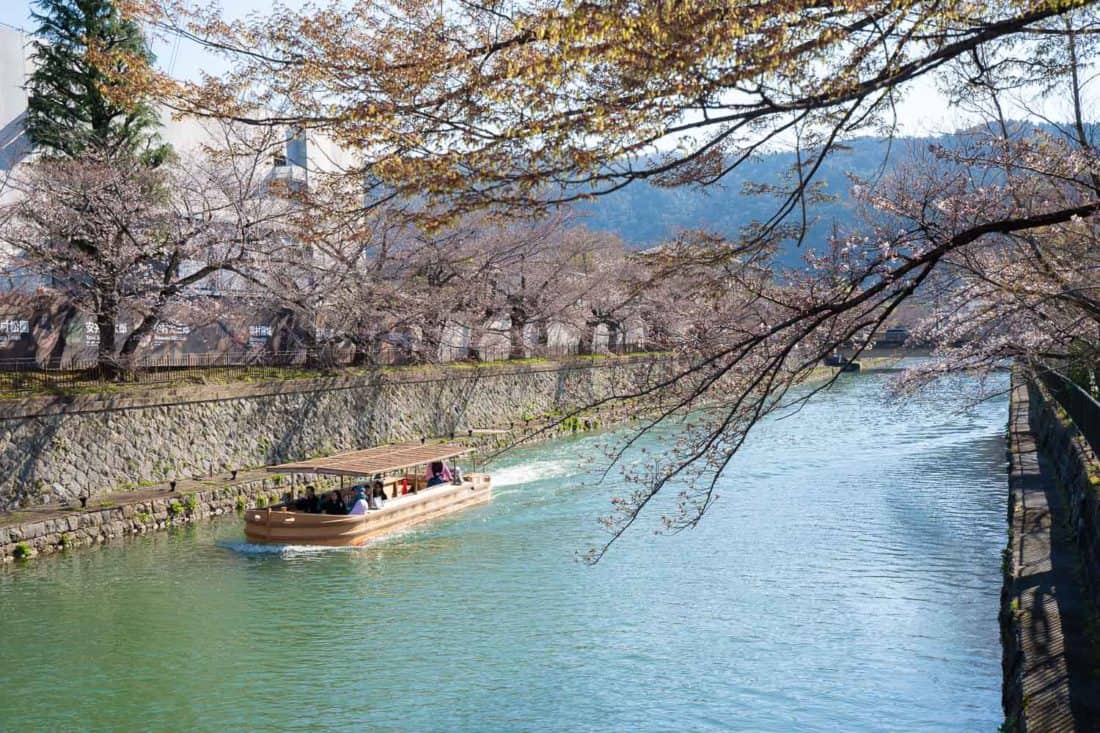
The Keage Incline is a disused cargo railway track that’s now a popular Kyoto hanami spot.
It had a few blossoms when we visited, but it’s more impressive in full bloom when the trees form a flower tunnel.
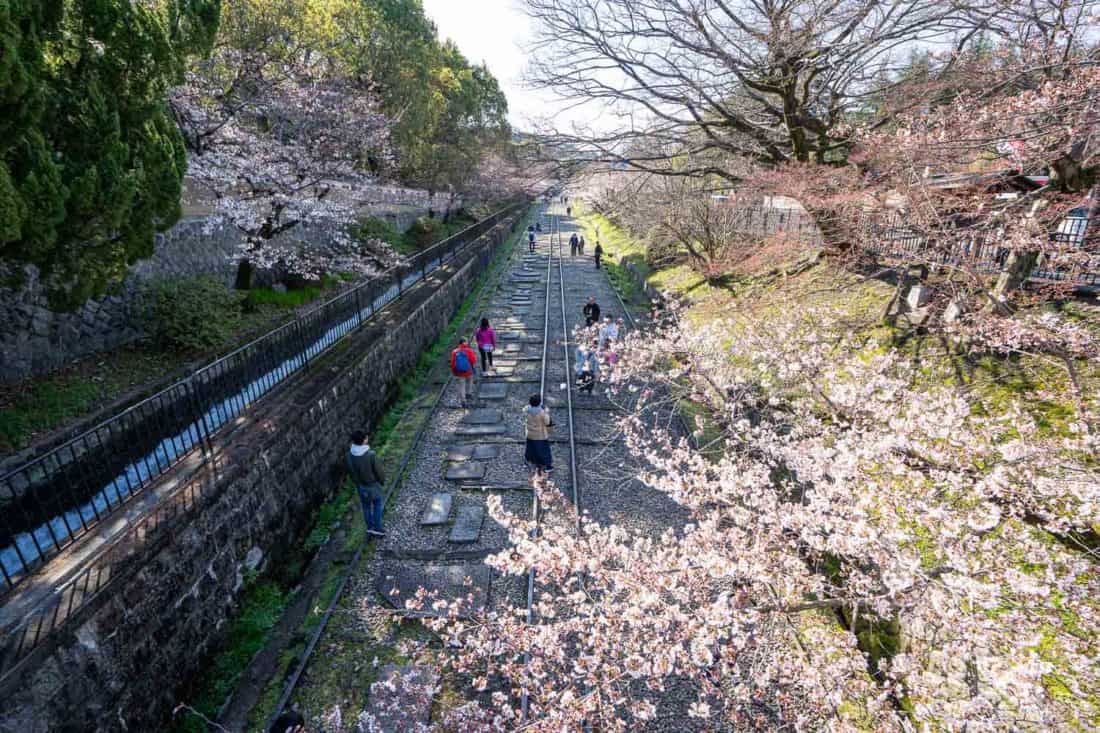
If you are in need of caffeine, the nearby Blue Bottle Coffee is excellent and opens at 8 am.
On the way to the next stop, you might want to visit Nanzen-ji Temple if you have time.
It’s a beautiful temple complex that’s worth visiting at any time of year and has a few cherry trees. Read more about it in my Kyoto temples guide.
5) Philosopher’s Path
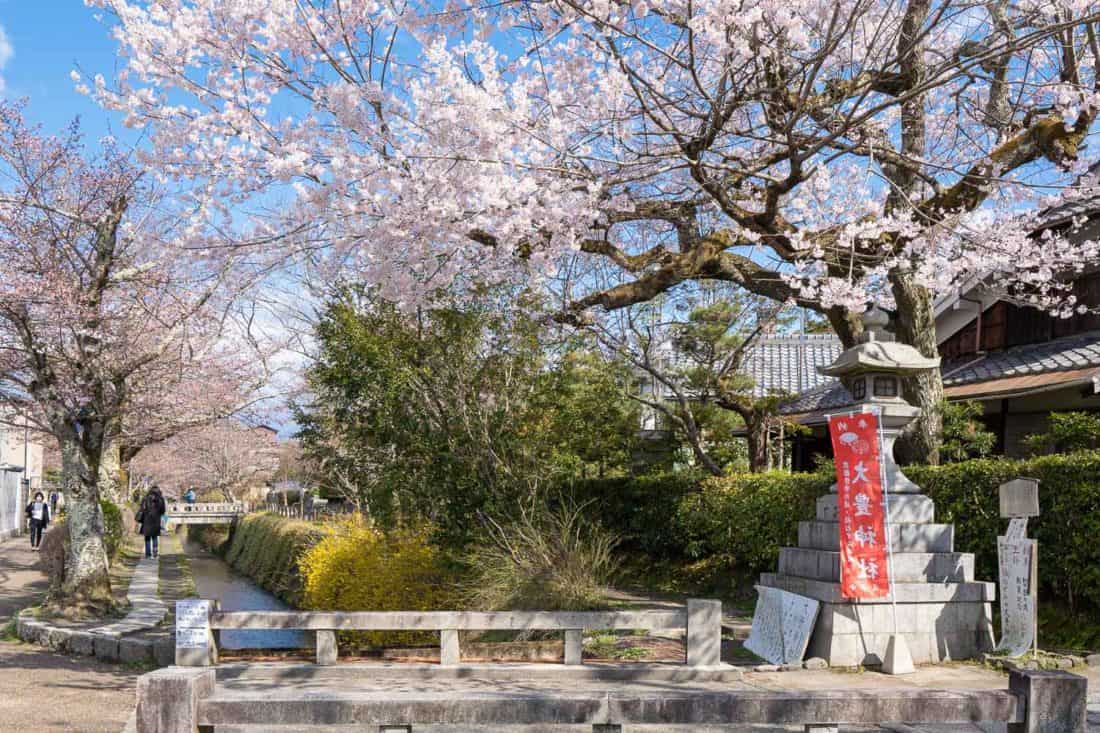
The Philosopher’s Path is often considered the best place to see cherry blossoms in Kyoto.
This 2km (1.2 mile) stone path runs next to a canal and connects Eikando temple (just past Nanzen-ji) with Ginkaku-ji.
There are a number of other temples you can stop at, but you won’t have time for them all in one day.
It’s a pleasant stroll with lots of cherry trees, but only a few trees were in full bloom on the 31 March.
At the height of the season it’s magnificent here, but you definitely want to arrive as early as possible to attempt to avoid the crowds.
At the end of the Philosopher’s Path near Ginkaku-ji we turned west into an untouristy area on Yoshida Hill where we found some much quieter cherry blossom spots—see the section below.
Food Tip: If you visit later in the day, you could combine the Philosopher’s Path with an early dinner at Monk, one of our favourite restaurants in Kyoto. It’s extremely difficult to get a reservation—see my Monk Kyoto restaurant review for detailed instructions on how to secure your spot.
6) Kamogawa River
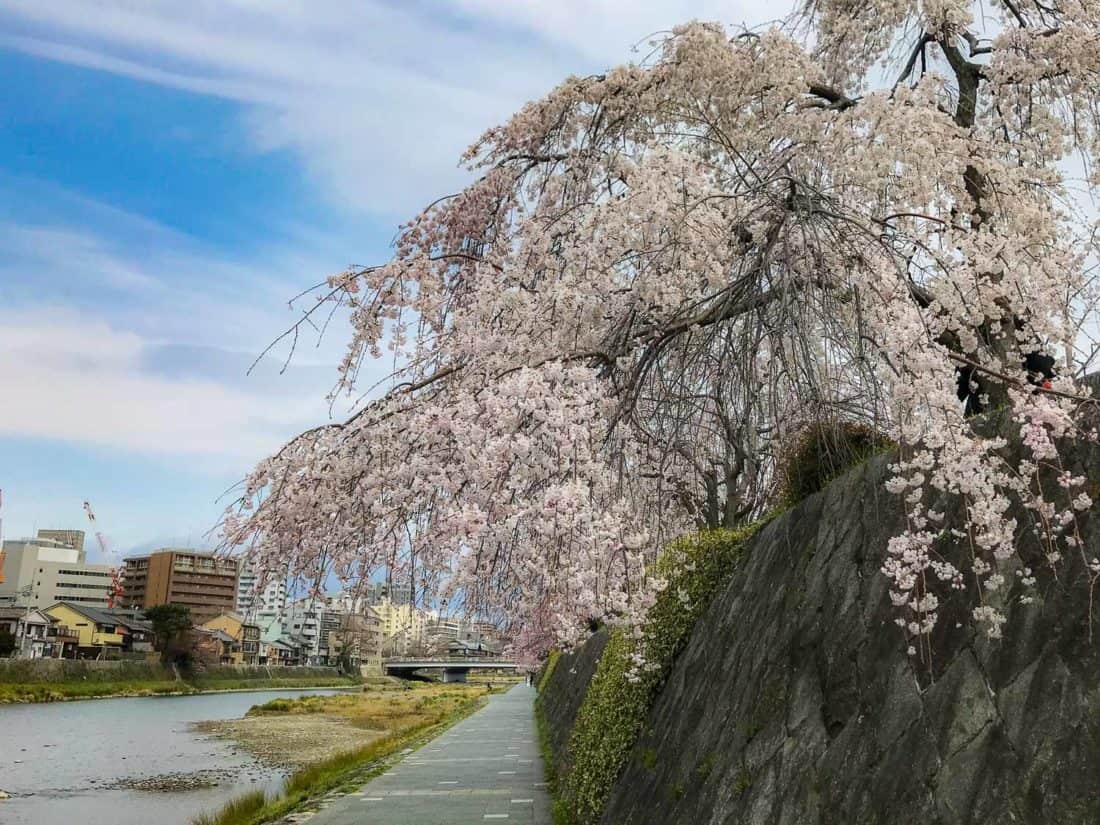
If you still have the energy after visiting our quiet spots below, continue to the Kamogawa, the river that runs through Kyoto.
A path runs alongside the river and it’s a fantastic sakura location with trees lining the banks.
Some sections get crowded, but it’s also possible to find quieter spots. Many locals have picnics on the grassy banks.
If you have an extra day, a great excursion would be to hire bikes and cycle along the river.
We found some beautiful early blooming trees just south of Kiyomizu-Gojo station.
You could cycle north from there and detour to the Imperial Palace and Kyoto Gyoen National Garden (another sakura spot).
Continue on to the Demachiyanagi area where the river forks, and take the left fork to head to the Kyoto Botanical Gardens, where you’ll find even more Kyoto cherry blossoms.
7) Shirakawa Canal in Gion
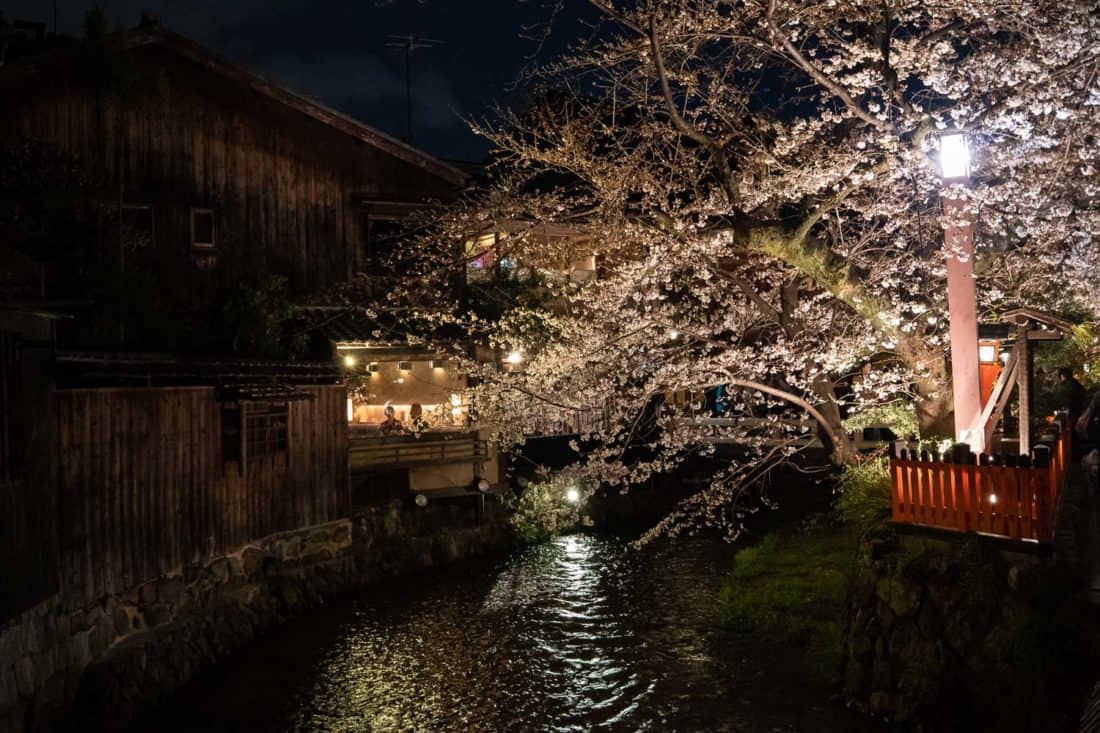
The Shirakawa Canal area of Gion is very pretty with wooden buildings and cute side streets.
There are many cherry trees along the canal and an impressive cherry blossom archway had peaked by 1 April.
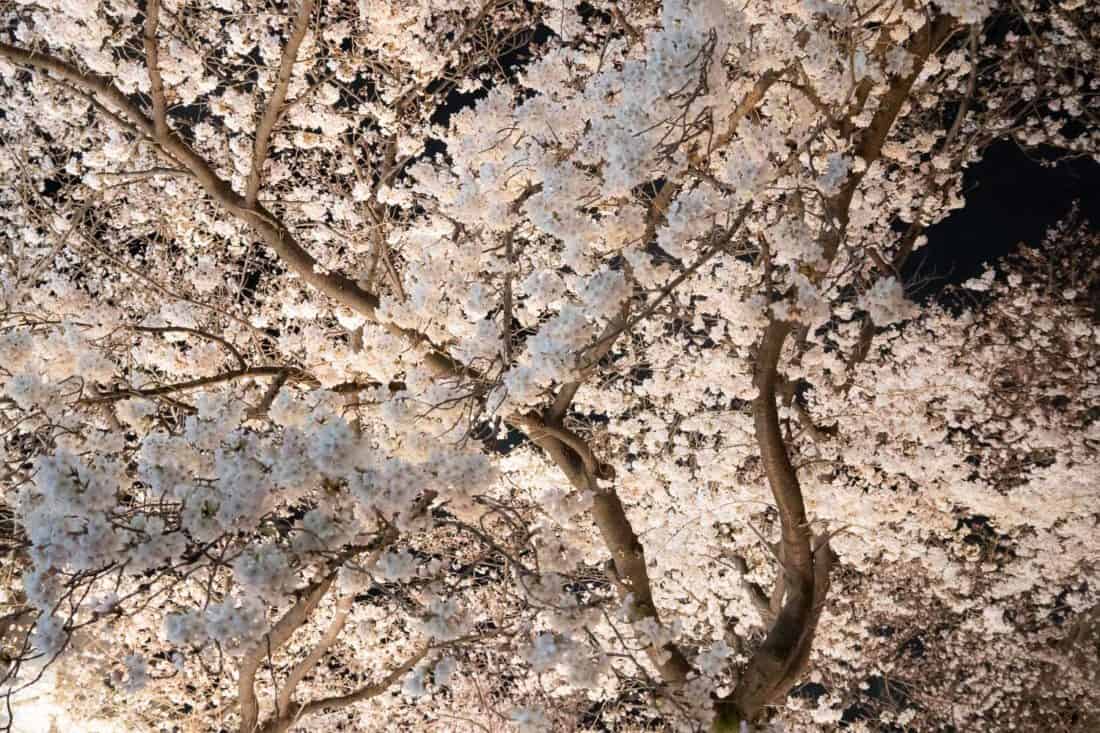
You could add this area to your itinerary in the morning, but it’s also nice to see illuminated at night. It gets very busy, though.
Kyoto Sakura Spots to Avoid the Crowds
If you are happy to continue walking after visiting Kyoto sakura spots 1 – 5 above, turn west to see some off-the-beaten-track temples where you can enjoy the cherry blossoms without the crowds.
The Buddhist temples and Shinto shrines listed 8 – 11 below are all on Yoshida Hill and are free to visit.
It’s about a 2 km (1.2 mile) walk from the end of the Philosopher’s Path to these places plus extra for exploring the temple grounds.
I’ve then shared some other quiet sakura spots we enjoyed in different parts of the city.
8) Takenaka Inari Shrine
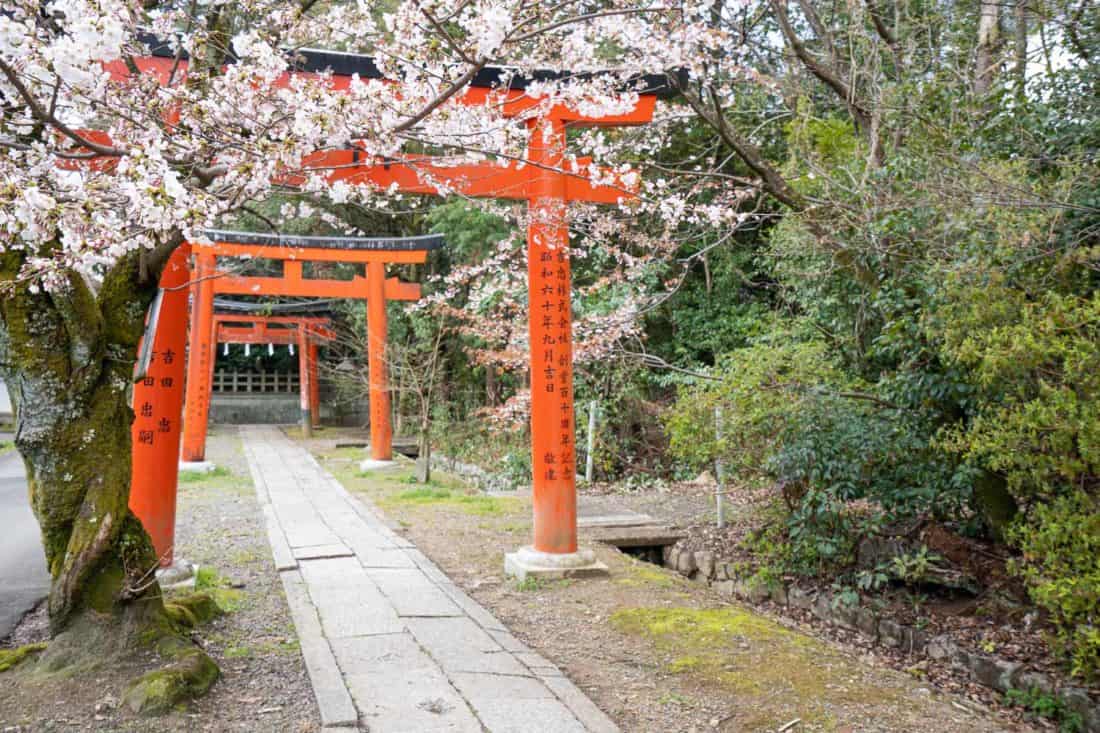
At Takenaka Inari Shrine I was excited to find the classic Japanese image of red torii gates framed with white cherry blossoms.
Even early in the season it was beautiful and there was only one other photographer around.
The atmosphere is diminished a little by the location next to a car park, but it’s still well worth the stop.
9) Yoshida-jinja Shrine
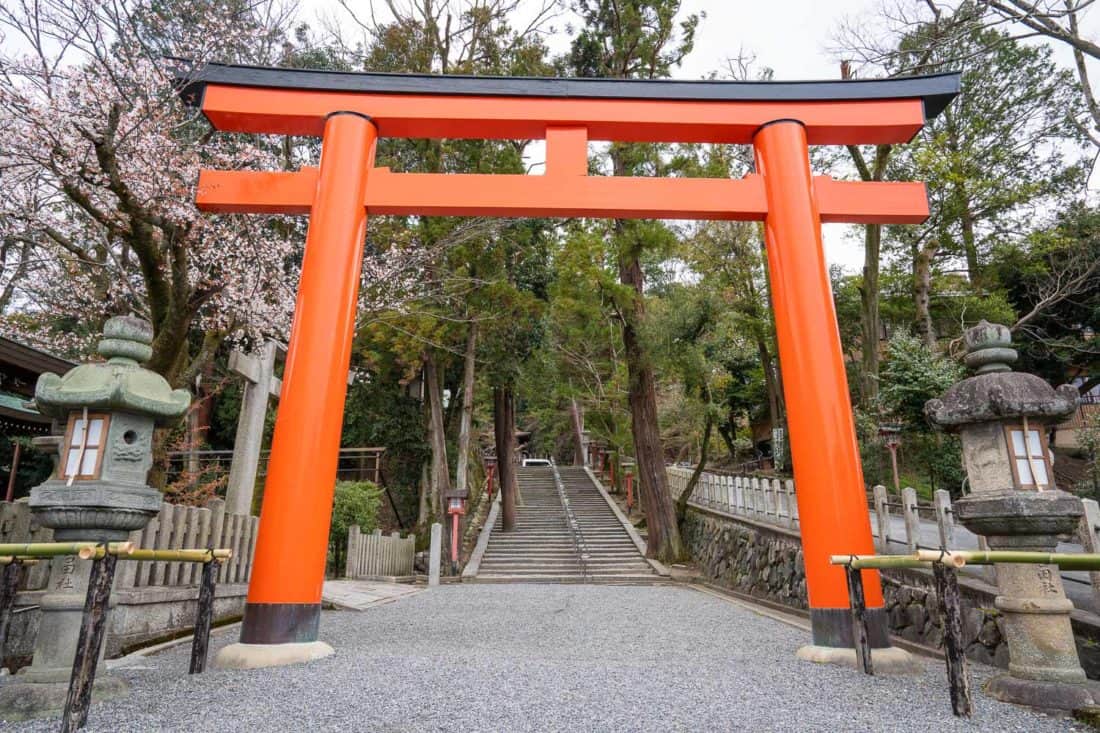
Yoshida-jinja Shrine is a five-minute walk from Takenaka Inari on the other side of the hill. It’s surrounded by forest and is very peaceful.
There’s one large cherry tree next to the torii gate at the entrance, but the flowers weren’t fully open yet.
The shrine complex didn’t have any cherry trees, but we saw a monk performing a ceremony and an interesting display of sake barrels.
On our way to the next temple we passed Saijōsho Daigengū, a sub-temple of Yoshida-jinja which features an attractive thatched roof building with a torii gate and cherry tree at the entrance.
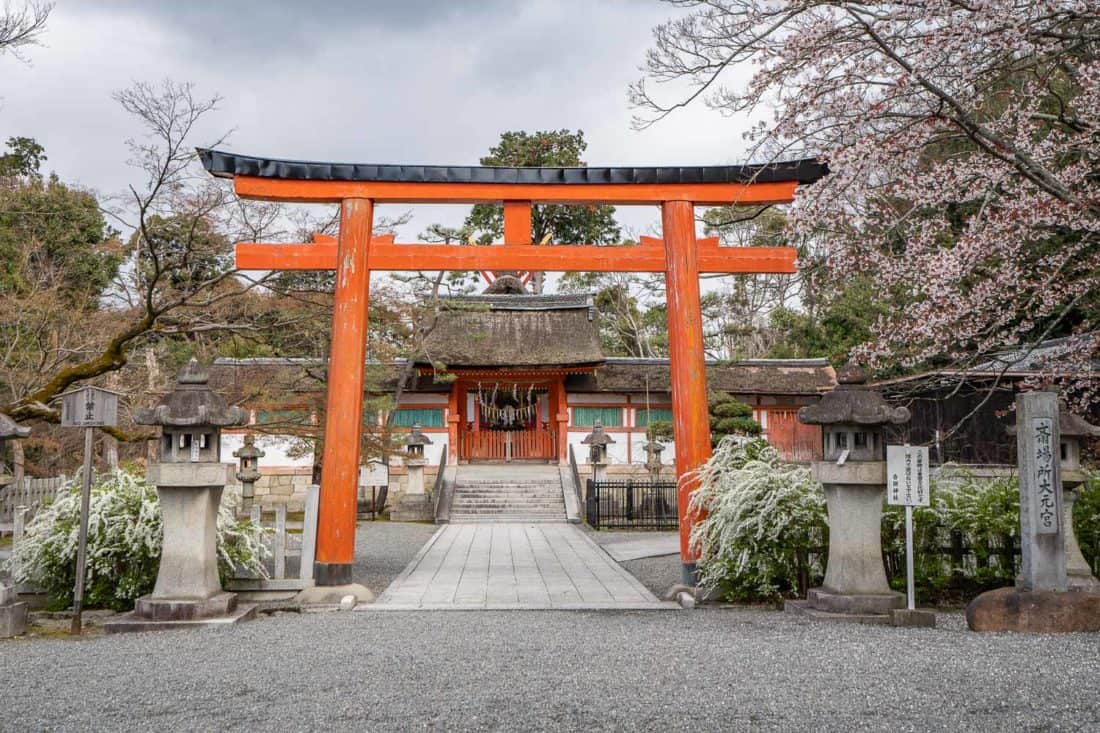
10) Shinnyodo Temple
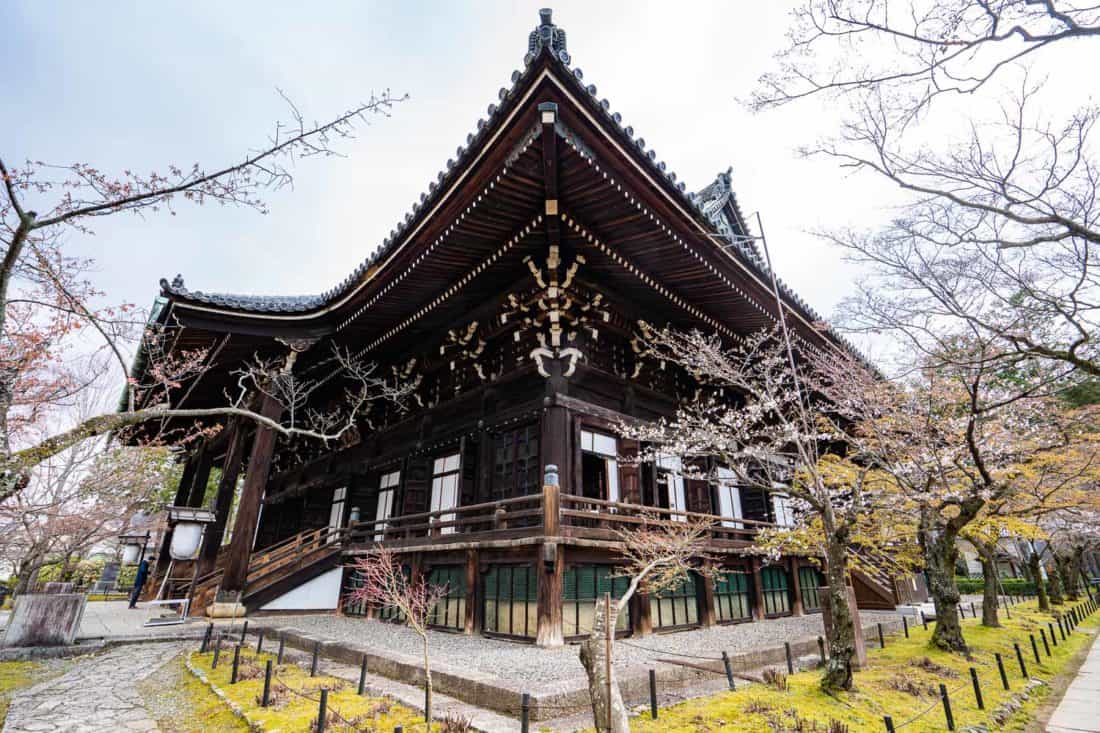
Ten minutes from Yoshida-jinja is the large Shinnyodo temple complex.
There’s a huge hondo (main hall), various other wooden buildings, and a small pond with cherry trees throughout. A week after we visited it would have looked lovely.
From here we walked through a huge hillside graveyard where there are fantastic views of the city. The next temple is down the hill.
11) Konkai-Komyoji Temple
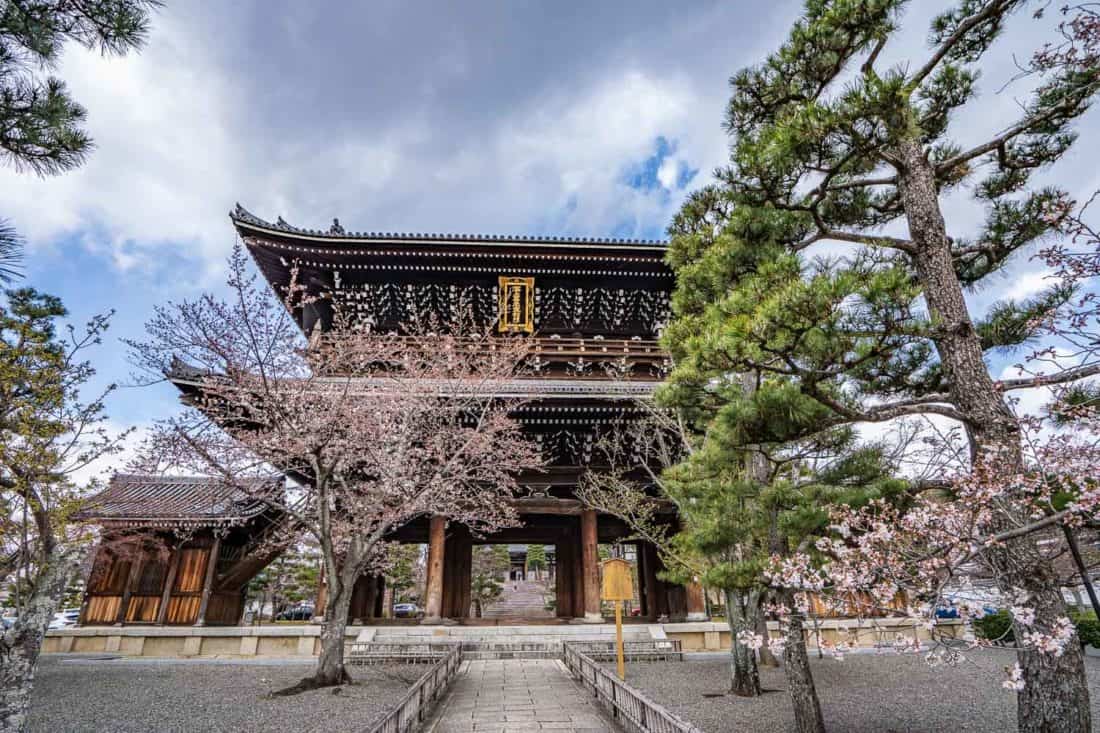
Konkai-Komyoji Temple is also known as Kurodani Temple and is a large and peaceful complex of wooden buildings. The main hall was originally built in 1175 but was rebuilt in 1605.
We entered through the back and left through the front. The entrance was my favourite part—a grand entrance gate and stairs up to the complex lined with cherry trees (unfortunately not in full flower). It would be gorgeous in full bloom.
12) Takase River
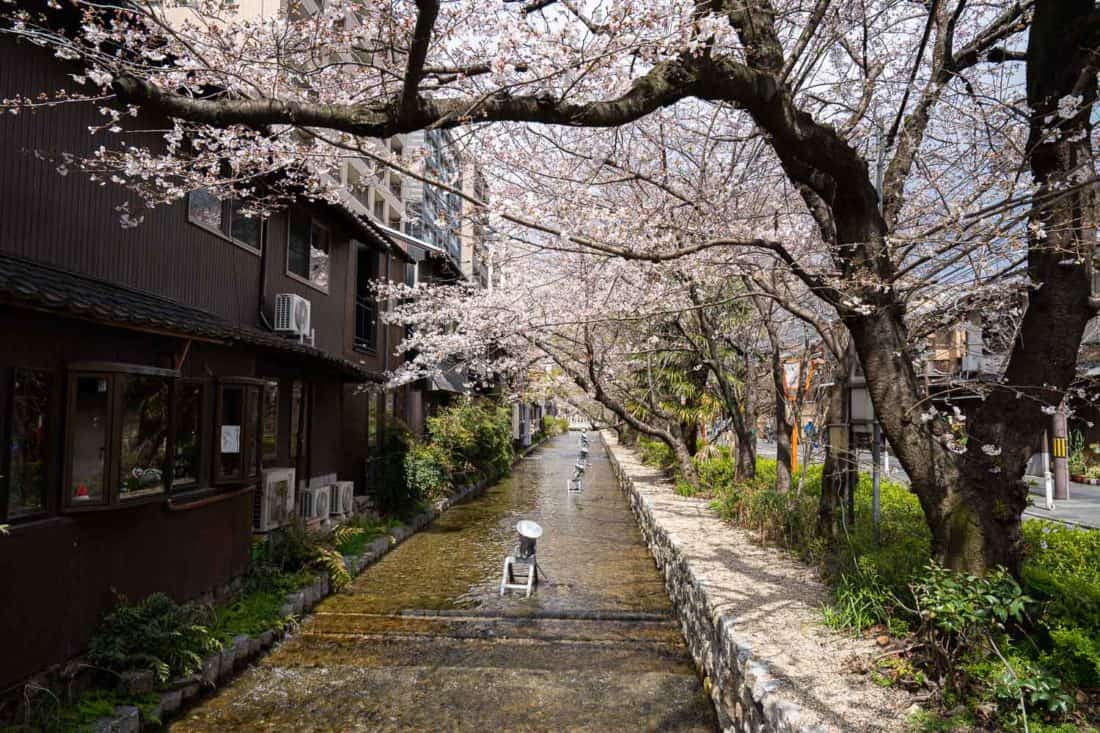
From here the walking tour that we suggested above ends. While you could continue to the Kamogawa and Takase River after the Yoshida Hill temples, it’s quite far and would be easiest by taxi.
We got a taxi to the river, had lunch then walked along the canal back to our apartment in Gion.
The Takase River is a narrow canal that runs parallel to the much larger Kamogawa River on the western side.
There are many blossoms along the canal and it’s a beautiful place for a stroll or lunch in one of the restaurants that overlooks it.
The section along Kiyamachi-dori between Sanjo-dori and Shijo-dori gets incredibly busy, but south of here is much quieter.
We often walked along the canal south of Gojo-dori and down past Kyoto Beer Lab and it was usually empty.
13) Jojakko-ji Temple in Arashiyama
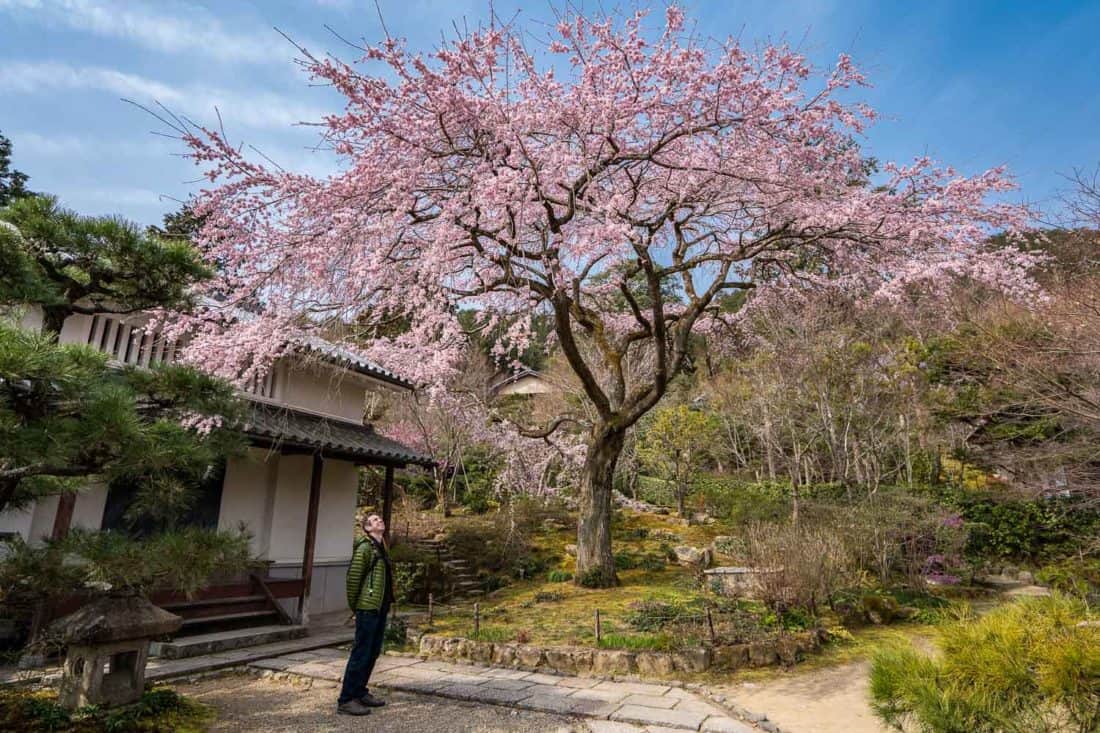
Arashiyama in western Kyoto is one of our favourite parts of the city with many temples to explore including the famous Tenryu-ji and quirky Otagi Nenbutsu-ji. It’s well worth spending a day in this area.
There are cherry trees along the river near Togetsukyo Bridge, but when we visited on 29 March they weren’t in flower.
We did discover a magnificent weeping cherry tree in Jojakko-ji Temple which isn’t very popular at this time of year (it’s much busier in autumn), so we had the tree to ourselves.
The hillside temple complex features many classic Japanese elements and is one of my favourites in Kyoto.
Entrance costs 500 yen.
14) Daikaku-ji Temple in Arashiyama
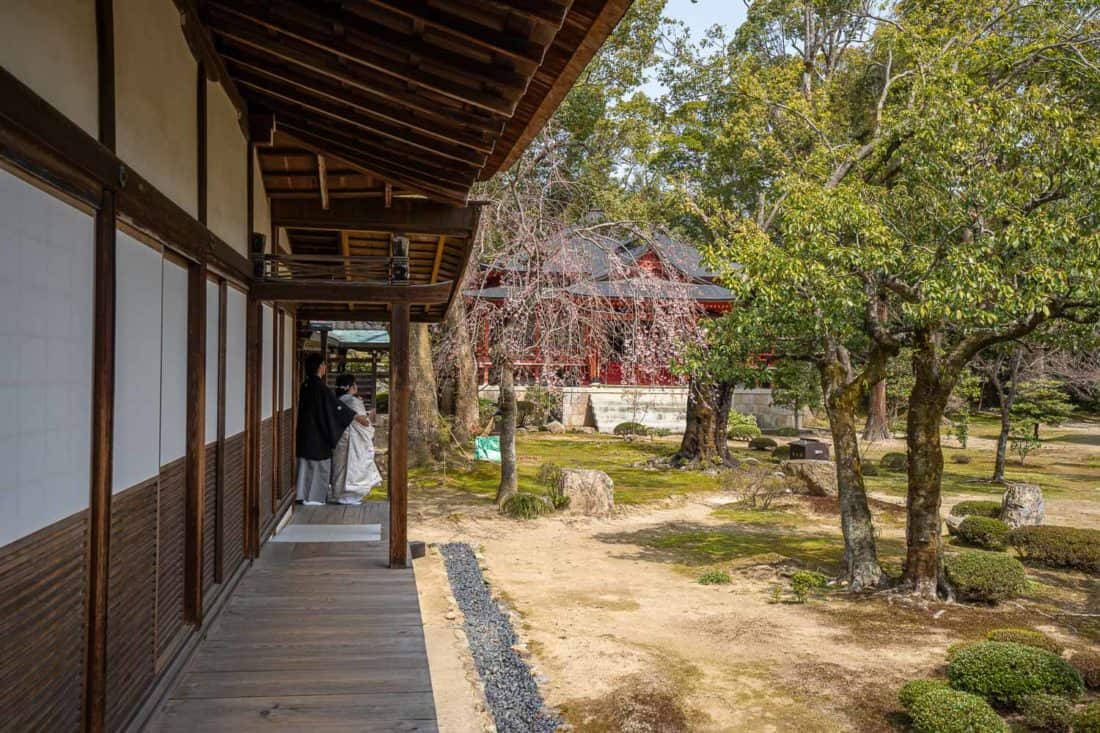
Daikaku-ji Temple is a fantastic cherry blossom spot, but perhaps because we were here early in the season it wasn’t busy at all.
This is one of Kyoto’s oldest temples and the complex feels very grand.
There was one cherry tree beginning to flower in the courtyard garden, but the main attraction in sakura season is the large pond surrounded by cherry trees.
A few had started to open when we visited and we could tell it would look amazing a week later.
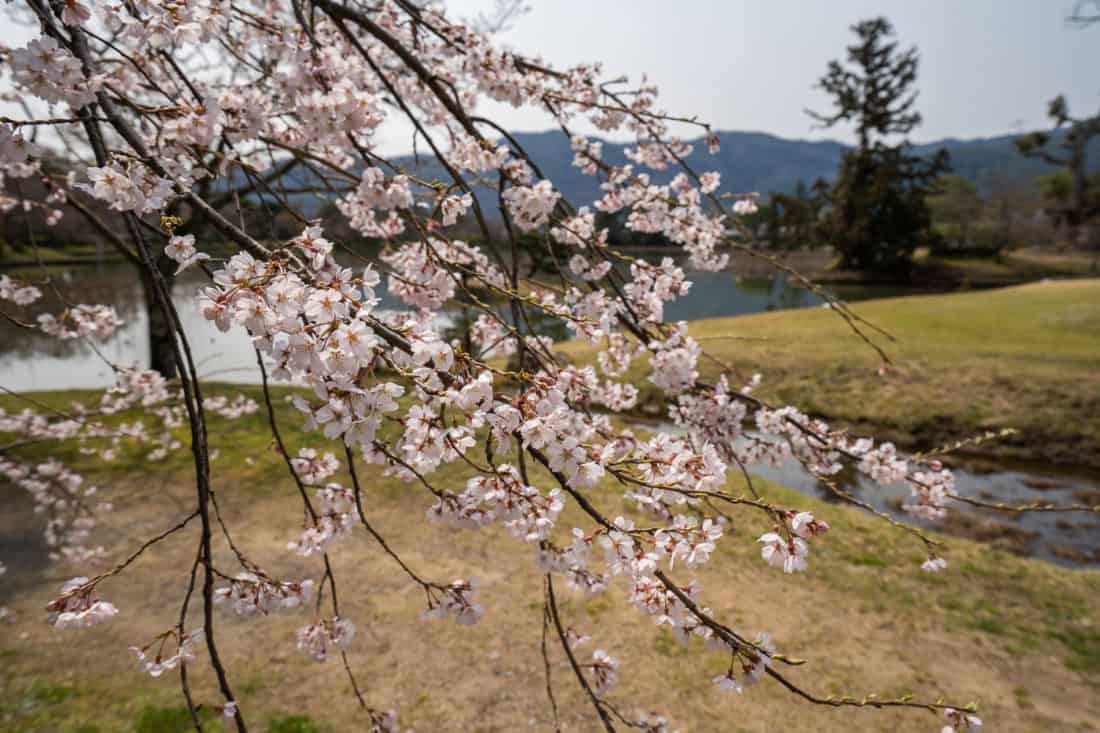
Entrance costs 500 yen to the temple area and 300 yen for the gardens and pond. Both are worth visiting.
Kyoto Cherry Blossom Map
See our favourite Kyoto sakura spots on this map. Blue pins are for the popular crowded places. Green pins are for the quieter spots.
Other Kyoto Spring Activities
While you are in Kyoto I highly recommend these other Spring events.
Geisha Spring Dances
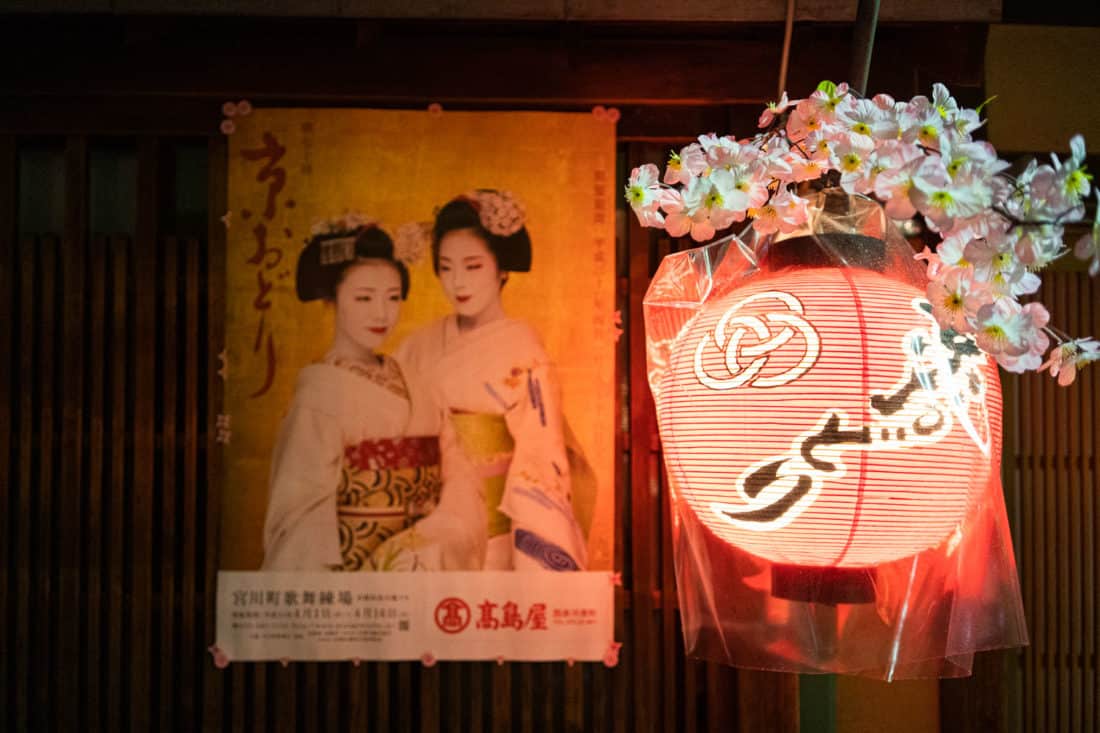
April in Kyoto is the time of the annual geisha dances (or geiko as they’re known in Kyoto).
The most famous is the Miyako Odori at the Gion Kōbu Kaburenjō Theatre in Gion, which runs throughout April. Tickets cost from 4000 – 7000 yen.
We went to the nearby Kyo Odori instead at the Miyagawachō Kaburenjō Theater, which is on the lovely traditional street where we spent a month.
Update 2025: The Kyo Odori will not be running in 2025 as they prepare for the opening of the refurbished theatre in 2026.
This isn’t a tourist experience. It’s a time-honoured tradition in the geisha districts, and there were very few foreigners in the audience (but lots of elegant Japanese ladies in kimono and even a few geiko).
The performance was spectacular and it was fascinating to get a closer look at the extravagant kimono, hairstyles and iconic white makeup we’d glimpsed while spotting geiko and maiko (apprentice geishas) in our neighbourhood.
The Kyo Odori usually runs every day (three times a day) for the first two weeks of April.
It’s easiest to buy tickets at the venue up to five days in advance.
We didn’t want to miss out and couldn’t make a payment on their website with an international card, so ended up booking via the HIS travel agency by email ([email protected]).
Tickets are 7000 yen including tea before the show.
Temple Night Illuminations
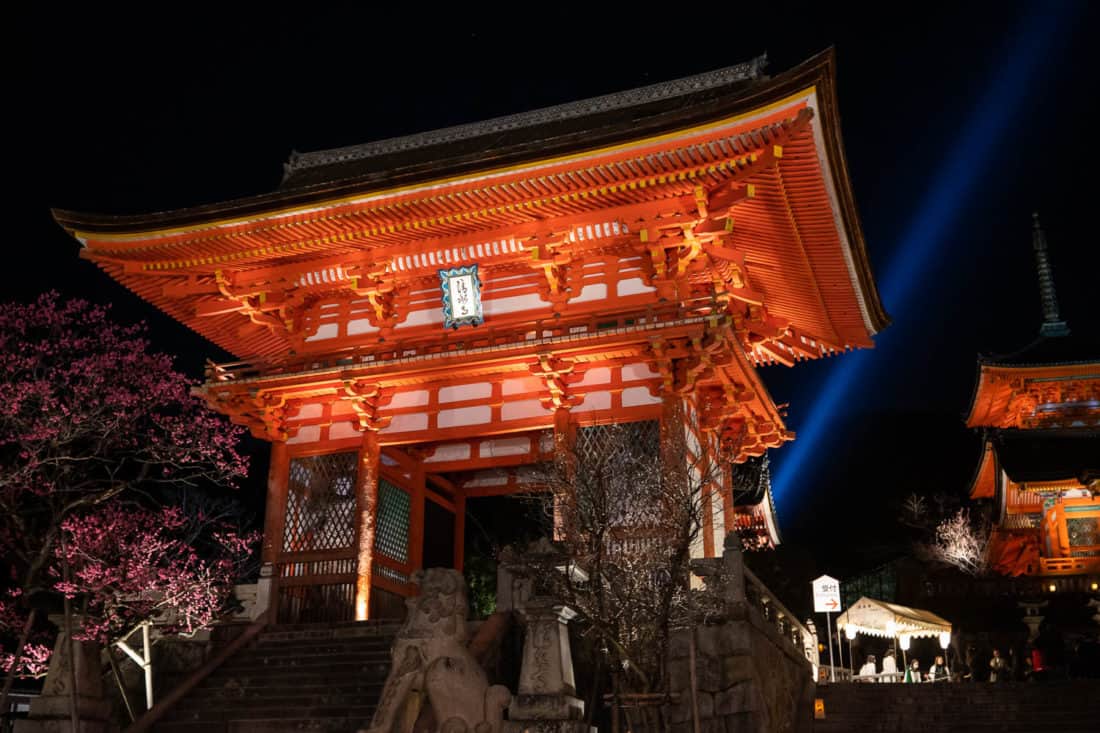
In spring (and autumn) several temples open at night for special illuminations.
Visiting a temple at night is atmospheric and feels like a different experience from a day visit, so I do recommend adding at least one to your itinerary.
These temples have spring night illuminations every year:
- Kodai-ji – From 14 March to 6 May 2025. From 5pm – 9.30pm. 600 yen.
- Kiyomizu-dera – From 25 March to 3 April 2025. From 6pm – 9.30pm. 400 yen.
You can also look out for other temples that might open for night illuminations on some years. Find a complete list on the Kyoto cherry blossom calendar.
Sakura Beyond Kyoto
Although we left Kyoto before full bloom, it ended up working out well as we had time to see the blossoms in other, less crowded parts of central Japan.
We bought a two-week Japan rail pass and followed this itinerary from Kyoto to Tokyo, where we spent our final week.
If you don’t have time to travel extensively around Japan many of the places below including Kinosaki Onsen, Okayama, and Himeji Castle are possible as day trips from Kyoto.
If you are looking for more inspiration, see our guides to the best places to visit in Japan and the top things to do in Japan.
Kinosaki Onsen (2 nights)
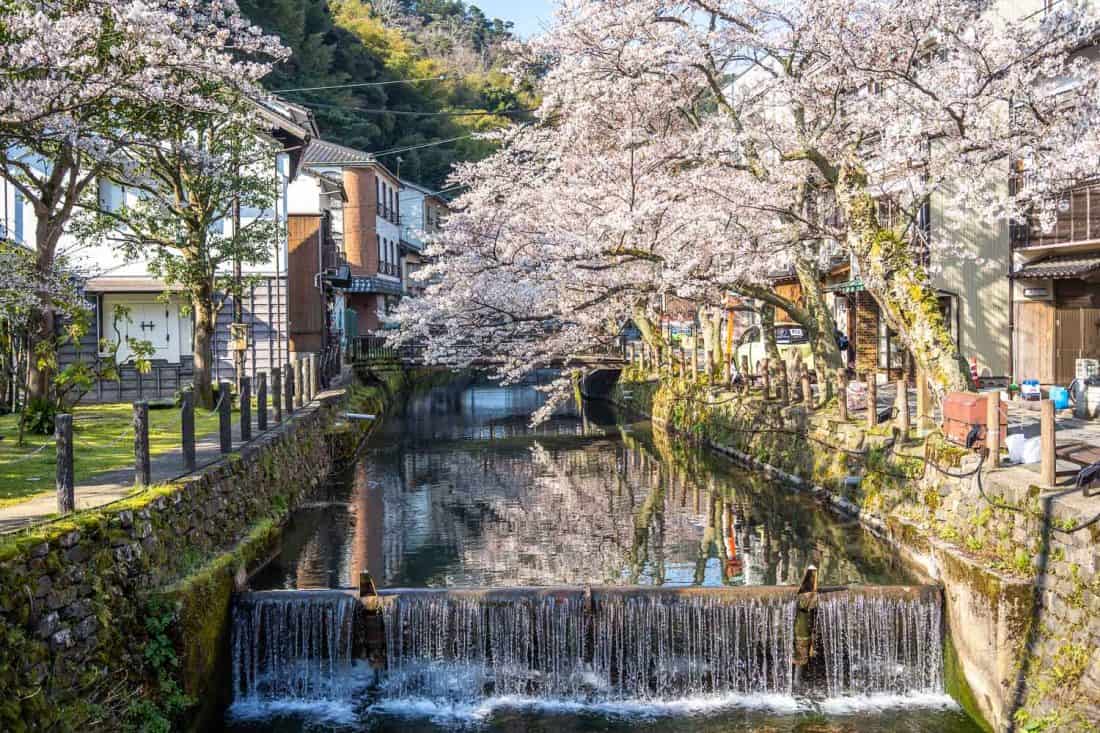
Kinosaki Onsen is a cute onsen town where you stroll between hot spring baths wearing a kimono.
The beautiful cherry trees lining the canals were blooming at the beginning of April and it wasn’t crowded.
Okayama (6 nights)
We used Okayama as a base for day trips to Naoshima island, Himeji, and Kurashiki. It also has some great hanami spots itself.
Okayama Korakuen Gardens is one of the most famous gardens in the country.
We actually preferred the sakura at the Okayama City Handayama Botanical Gardens which feature over 1000 cherry trees on a hillside and lots of grassy areas for picnics.
This was our favourite sakura spot in all of Japan and most tourists don’t know about it.
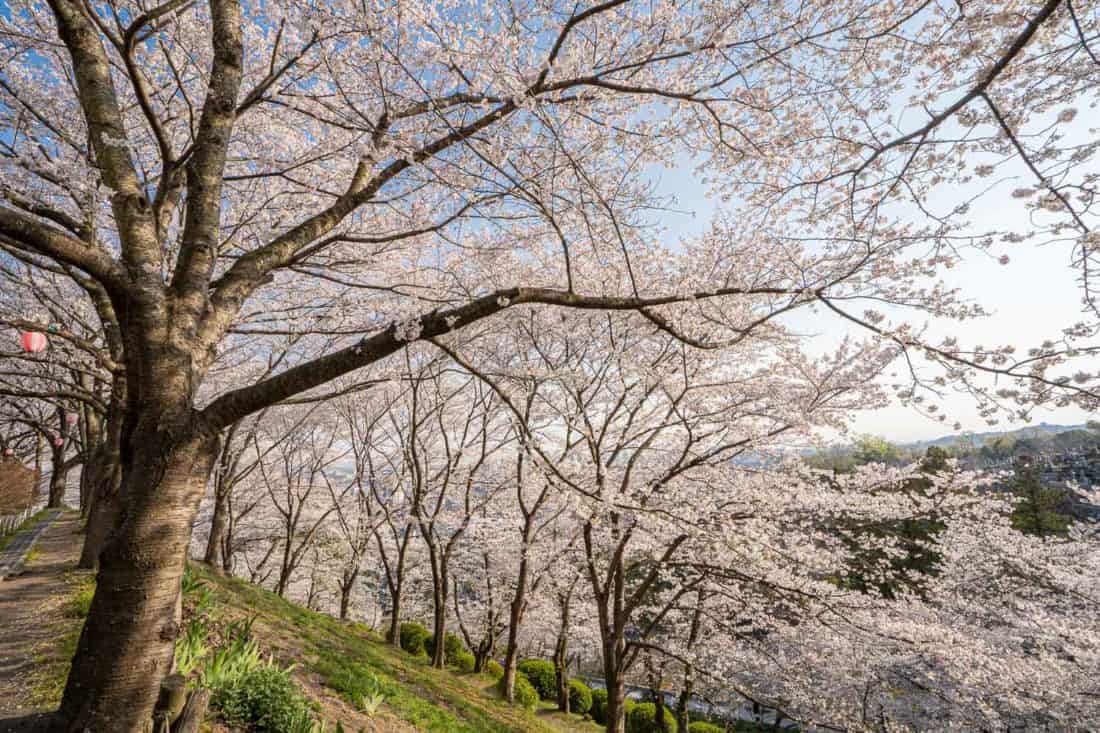
We also enjoyed the cycle ride on the Kibiji bike path between Bizen-Ichinomiya and Soja train stations which took us to some lovely quiet temples and cherry blossom spots.
Naoshima Art Island is more known for its contemporary art galleries than cherry blossoms, but we enjoyed quite a few trees as we cycled around the lovely little island.
It’s an easy day trip from Okayama and a much longer one from Kyoto.
Read our Okayama guide for more details.
Himeji Castle (day trip)
The extensive gardens outside Himeji Castle feature about 1000 cherry trees and are a popular hanami spot.
We visited in the late afternoon so we could also stay for the night illuminations.
Kawaguchiko (3 nights)
It’s a long trip from Okayama to Kawaguchiko (train to Mishima then bus), but we couldn’t resist seeing Mount Fuji framed by cherry blossoms.
The season starts later here so in mid-April the cherries were blooming, despite the fact we had freezing temperatures and even some snow.
The northern shore of Lake Kawaguchiko has lovely Mt Fuji views and plenty of cherry trees.
See our Lake Kawaguchiko guide for more tips.
The most famous view is from Chureito Pagoda, which is a 15-minute train ride away near Shimoyoshida Station.
Even at 8 am is was insanely busy with a queue of hundreds waiting to take the perfect shot of Fuji-san with the red pagoda and blossoms in the foreground (we didn’t wait and got this alternative view instead).
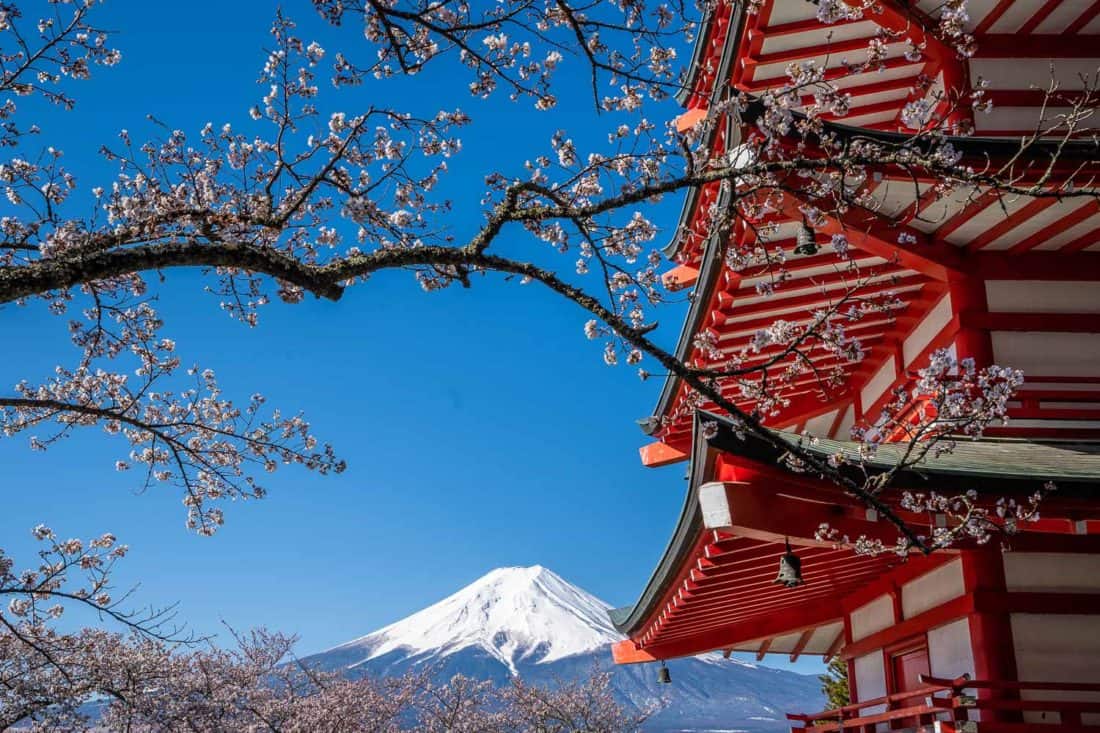
Tokyo
By the time we arrived in Tokyo in mid-April, we knew we were long past the sakura season.
So we were pleasantly surprised that Shinjuku Gyoen park has many late-blooming cherry trees.
The weather was warm and sunny and the trees so beautiful that we ended up having three picnics in the park during our week in the city. It’s one of our favourite things to do in Shinjuku.
Read our tips for the best things to do in Tokyo.
Is Kyoto Cherry Blossom Season Worth it?
I was a little worried that Kyoto in cherry blossom season might be overrated. While it’s undoubtedly a busy and expensive time to visit, it was well worth braving the crowds as the sakura are magical and the atmosphere one of lively celebration.
I recommend getting up early to visit the popular sakura spots and then hunting out some quieter gems later in the day where you can relax and enjoy the blossoms.
It’s also worth taking some day trips or overnight stays to some of the surrounding destinations like Okayama which aren’t as crowded.
If you’ve seen the cherry blossoms in Kyoto, let us know your favourite spots below.
More Japan Posts
Kyoto
- 31 Unforgettable Things to Do in Kyoto, Japan
- Where to Stay in Kyoto: Recommended Hotels and Areas
- 20 Best Vegetarian Restaurants in Kyoto
- The Ultimate Guide to Kyoto Temples and Shrines
- 15 Best Day Trips from Kyoto
- Kyoto in Autumn: 10 Stunning Fall Foliage Spots
General Japan Tips
- Planning a Trip to Japan: Dos and Don’ts
- 16 Unmissable Places to Visit in Japan
- 56 Best Things to Do in Japan for an Unforgettable Trip
- 2 Week Japan Itinerary
Enjoyed this post? Pin for later!
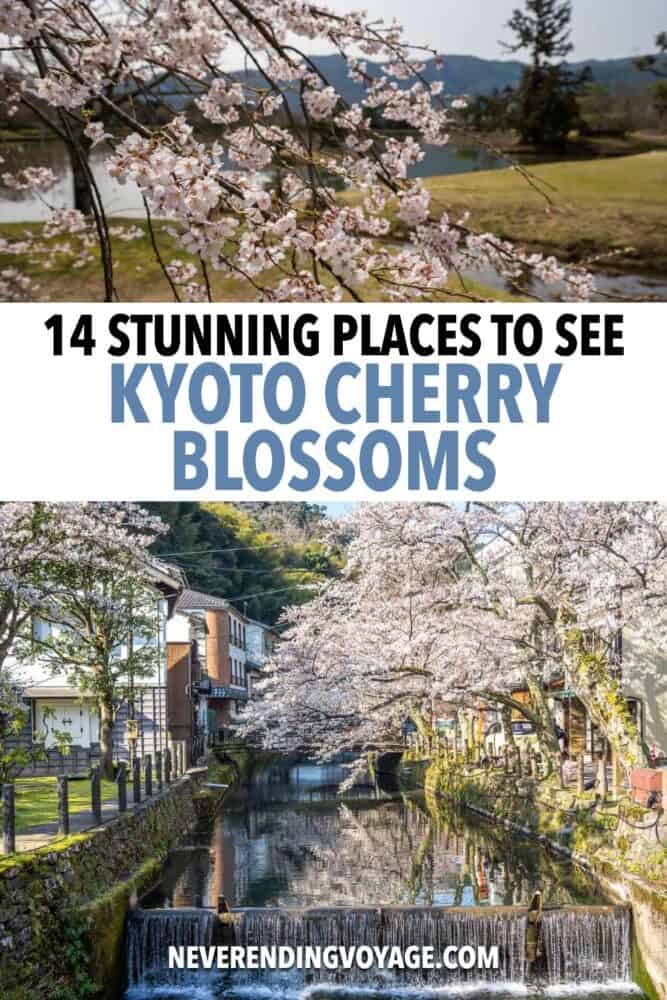
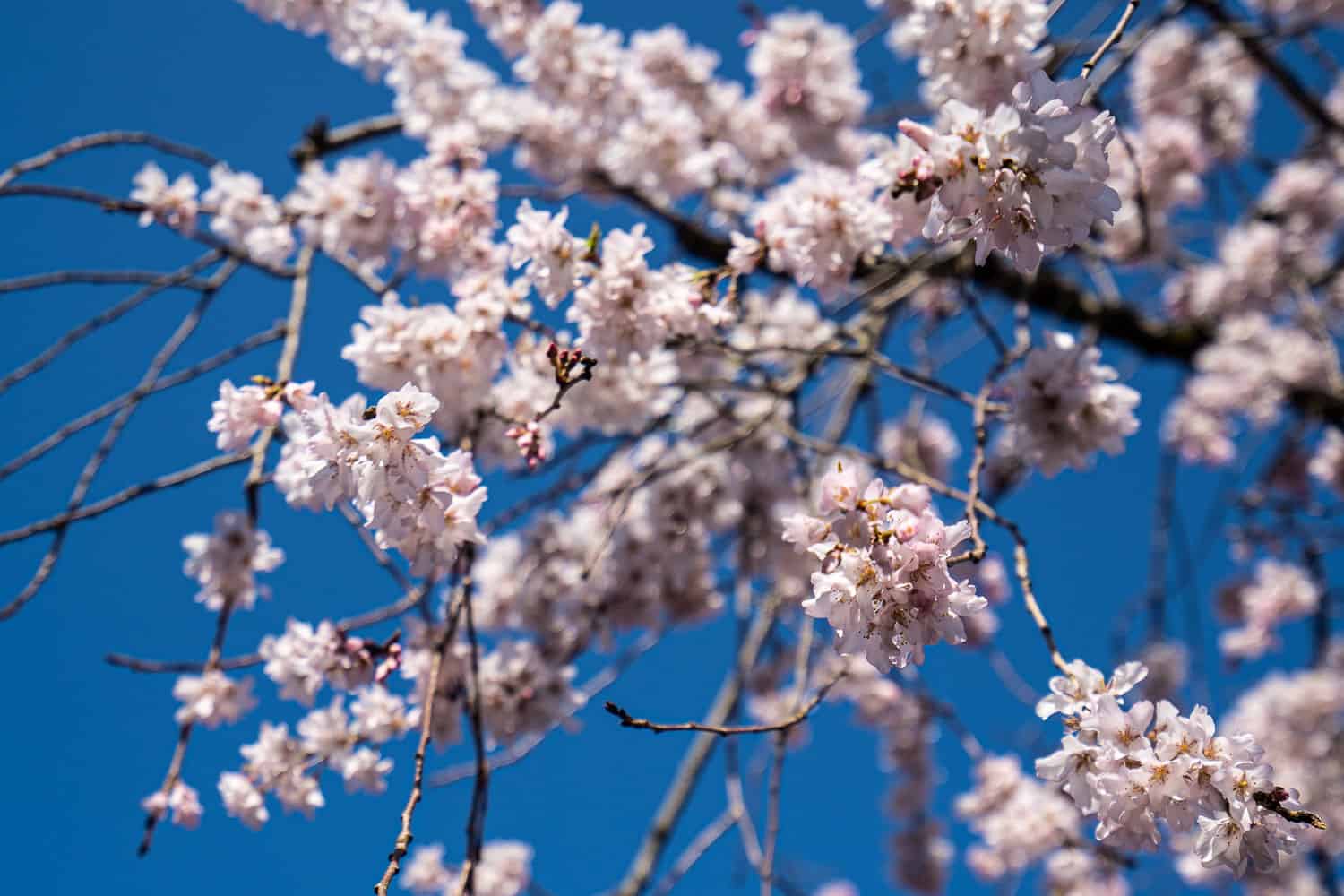
Hi Erin
Firsty, I can only reiterate all the praise that people have commented on the quality of your blog. I am so glad I came accross it!
We are looking at a trip in the lat two weeks of April 2024. I saw another blog talking about places in Kyoto where there are late blooming CBs eg Heian Jingu(Shirine)? I assume there will be some but just not the volume/scale as in the fist weeks?
Would there be places on your two week itenary, which basically I’m following, that might be a better chance in second half of April?
Seprately, do you have any sense how crowded Kyoto would be in third week of April; obviously, less than first two weeks…but?
Thanks
Grant
Hi Grant,
We haven’t been to Kyoto in late April so I can’t comment from experience. There could well be some late blooming spots, but I wouldn’t bank on seeing many blooms at that time. I think the petals fall off quite quickly after full bloom (which seems to be getting earlier).
Your best bet is going further north. We were in Lake Kakaguchiko in mid April and they were just starting to bloom (but it also snowed!).
You might also have a chance in Takayama and Nikko. It all really depends on the weather that year though.
We were in Tokyo from 17- 23 April and there were lots of late blossoms in Shinjuku Gyoen where we enjoyed many picnics. They were a different kind of petal than the typical one (much bigger and puffier) but still beautiful.
I am sure you will find some beautiful sights!
Expect Kyoto to be busy but it’s worth it. My Kyoto post has tips on avoiding the crowds.
Enjoy Japan!
Erin
Planning my Japan 2022 trip and this blog has been an incredible resource! Thanks for this
Thanks Kristen – I’m glad you’ve found it useful! Happy planning!
This is wonderfully written and I cannot wait to discover some of the areas you have described! Sadly, we may only have a day, two at max, but we’ll be there during Sakura season too. Many thanks for sharing your experiences and insights :)
Enjoy – it’s a magical time of year!